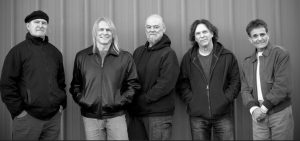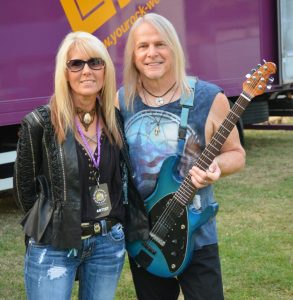
“Fusion” is a musical term commonly used to describe a mix of jazz influence with electric rock. It’s a blend that started in the late 1960s and early 1970s, popularized separately by artists such as trumpeter Miles Davis and guitarist/vocalist Frank Zappa, who created disparate versions and catapulted band members toward future careers — from Herbie Hancock, Wayne Shorter, Tony Williams, Joe Zawinul, John McLaughlin, Chick Corea and Keith Jarrett to Terry Bozzio, George Duke, Jean-Luc Ponty, Steve Vai, Adrian Belew, Mike Keneally and Vinnie Colaiuta.
But among Davis’ electric jazz and blues excursions and Zappa’s often-humorous classical embellishments was another inimitable early member of the club. The Dixie Dregs perform at the Culture Room in Fort Lauderdale on Friday with original members guitarist Steve Morse and bassist Andy West, long-standing violinist Allen Sloan and drummer Rod Morgenstein, and guest Dream Theater keyboardist Jordan Rudess.
The Augusta, Ga.-spawned quintet has not only encompassed instrumental jazz, blues, rock and classical styles, but also included humor and progressive elements of country, bluegrass and Celtic music since Morse and West first formed as Dixie Grit in 1970. Forget the convenient “instrumental rock” and “Southern rock” tags that writers have used because of Morse’s metallic speed and the group’s intermittent use of standard 4/4 time signatures. Picture a cross between the Allman Brothers Band’s jamming excursions and those of guitarist McLaughlin’s scintillating Mahavishnu Orchestra, and you’ve dipped a toe into a vast musical body of water.
“We kind of grew up together as a band,” West says from his home in Arizona via a Zoom meeting, “which is unique. It’s hard to describe what we do, other than to say we’re in the canon of rock music, which we fit into somehow. But there’s all these different influences, along with beauty and power. Just no words. But there’s a long history of music without words, and I honestly don’t think anyone else has the same kind of sound we do. So if you can appreciate this kind of sound, we might be the only place to get it from.”
West is one of the historic bassists who plays primarily with a pick, and he and Morse eventually moved farther south to study at the University of Miami School of Music. As part of the school’s “Rock Ensemble II,” they were jamming by 1973 with Morgenstein, who’d succeeded three previous drummers, and future doctor of anesthesiology and pain management Sloan. That core quartet, along with student keyboardist Frank Josephs, recorded a 10-song demo album titled The Great Spectacular live in the studio at the university. It was released as a Dixie Dregs limited-edition LP in 1975 and eventually as a CD in 1997.
“It was a dynamic scene at the school then,” West says, “with people like Jaco Pastorius, Pat Metheny and Hiram Bullock popping in and out. Steve studied classical guitar there and already had a direction, and being around those kinds of players pushed us. He also had a little recording experience, and that was the era when the four-track Tascam tape recorder came out. Studios were very hard to get into at that point, so we were fortunate to be able to record at the school’s facility.”
“The recording process was bizarre,” Morse says of the sessions, “since we were trying out the recording stuff that had just been installed at school. We worked a few nights after school with limited experimentation.”
In spite of the group being an impossible-to-pinpoint instrumental act, the Dixie Dregs couldn’t be ignored by recording labels. The group was signed in 1976 to the Macon, Ga.-based imprint Capricorn, home to the Allmans as well as other regional faves such as Bonnie Bramlett, Delbert McClinton, the Marshall Tucker Band, Wet Willie, and Sea Level.
Its 1977 debut, Free Fall, featured cover art of the band jumping out of an airplane led by Morse, a future airline pilot. The instrumental format resulted in modest sales, mostly to other musicians who raved about its six-minute centerpiece. “Cruise Control” was a breakneck rocker with high degree-of-difficulty traded solos between Morse, West, Sloan and keyboardist Steve Davidowski that got shorter and more interlocking, while Morgenstein anchored the frenetic rhythm. The track became a staple in live performances.
The 1978 sophomore album What If, with former Dixie Grit keyboardist Mark Parrish replacing Davidowski, went one step beyond. Its title track and closing “Night Meets Light” approximated classical pieces performed by a miniature electric orchestra; the raucous opener “Take It Off the Top” and epic “Odyssey” also became concert staples, and “Ice Cakes” and “Gina Lola Breakdown” simultaneously showcased the quintet’s tongue-in-cheek homages to the sounds of New Orleans and Nashville. The album also featured a rare track not written or co-written by Morse, the band’s leader and composer. West’s “Travel Tunes” went from boil to circus-themed simmer and back, with a fiery Morse solo in its midsection.
“That tune also came out of that four-track recorder era,” West says. “Steve brought the guitar lines and chordal patterns, but I’d otherwise written and recorded the melodies and the form. Standing next to Steve with your own composition is daunting, but we were working for the first time with producer Ken Scott, who we’d always wanted to work with because he’d engineered for the Mahavishnu Orchestra, one of our heroes. Ken had us play all of our tunes, and that was one of the ones he chose.”

As usual, such instrumental prowess was recognized more in Europe than the United States. The band’s tour to support What If included an invitation to perform at the 11th annual Montreux Jazz Festival in Switzerland in 1978. A rousing, well-received set would yield the concert half of the band’s acclaimed live-and-studio LP, Night of the Living Dregs (1979). Its highlight was “The Bash,” a rearrangement of the traditional “Wabash Cannonball” featuring Morse’s warp-speed picking. The crowd erupts both during and after the raveup, and the entire 45-minute set is featured on the 2006 DVD Live at Montreux 1978.
“By the time we got to Montreux, we‘d toured a lot playing those songs,” West says. “We’d crafted sets to win over an audience, and the audience there definitely didn’t know what to expect from us at first. But they increasingly got into it. It was the right moment in time for us.”
Like many acts that had found any level of success in the 1970s or earlier, the Dixie Dregs had trouble transitioning into the comparatively unsubstantial and video-dominated 1980s, even with a gifted new keyboardist in T. Lavitz. Capricorn declared bankruptcy, so the group signed a three-album deal with Arista Records, releasing Dregs of the Earth in 1980. They then shortened their name to The Dregs for Unsung Heroes (1981), and added vocals by the Doobie Brothers’ Patrick Simmons and Santana’s Alex Ligertwood to tracks on Industry Standard (1982).
A busy Dr. Sloan was replaced for the latter by Mark O’Connor, whose dexterity on both violin and guitar resulted in scintillating interplay with Morse, especially during live shows. Yet the changes never resulted in increased sales. Industry Standard, its title approximating a middle finger to the music biz, would be the last studio album West would appear on as the group disbanded from 1983-1988. He’d go on to become vice president for analytics and adaptive learning at Pearson Education, a London-based textbook, test and assessment subsidiary company.
“I’m retired now, but I was able to make a living in that business,” says West. “Our band had reached a certain level of success, but we were asking, ‘How can we get more people to listen to us?’ People were calling us The Dregs anyway, so we figured we could just be called that. We’d opened for the Doobie Brothers and Santana, and they loved our band, so we came up with the idea of having those guys work with us on a couple songs. But we still didn’t achieve a greater level of financial success.”
A frustrated Morse would form his own self-titled trio (now featuring bassist Dave LaRue and drummer Van Romaine), which opens The Dixie Dregs’ Anachronicity Tour 2024 shows, during that five-year hiatus. He also became the short-lived guitarist for classic rockers Kansas, a move he’d re-create in longer form with Deep Purple from 1994-2022. Morgenstein started a long association with rock band Winger, and later teamed up with Lavitz (1956-2010) in Jazz Is Dead, a fusion tribute act to the Grateful Dead. The drummer also continues a long career in instruction online through the Berklee College of Music in Boston.

Morse recently lost his wife, Janine Morse, in February after her long battle with Stage 4 cancer. She’d been an ardent fan and supporter of The Dixie Dregs, and an inspiration for the group reuniting for tours over the past several years.
“We had a rehearsal scheduled, and Janine passed away right before it,” says West. “We went to the funeral, and found out Steve still wanted to rehearse to try to take his mind off of things. He was understandably distraught, but we were able to run through the tunes. Janine really wanted us to play together again, and to come on this tour with us.”
From 1988 onward, The Dixie Dregs — with the Southern part of its name reinstated — have toured occasionally while its members participated in other projects and professions. LaRue capably replaced West from 1988-2016, as evidenced by the 1992 concert recording Bring ’Em Back Alive, which features a reinterpretation of Led Zeppelin’s “Kashmir” as well as a cover-chocked “Medley (Take It Off the Top),” plus “Cruise Control” and other original faves.
LaRue also recorded on the band’s only subsequent studio recording, Full Circle (1994), which features another fiery Sloan replacement in former Mahavishnu Orchestra violinist Jerry Goodman, who stayed in the lineup through 2016. It also contains the band’s lone studio cover tune, The Yardbirds’ “Shapes of Things.” On the 2000 live recording California Screamin’, recorded over three nights at the Roxy Theater in Los Angeles, Morse, Morgenstein and Lavitz alternately team up with West and Sloan, and LaRue and Goodman. The results include retellings of “What If,” “The Bash” and “Full Circle” material along with the Allmans’ “Jessica” and Zappa’s “Peaches En Regalia,” played with the late icon’s guitar-playing son, Dweezil Zappa.
A 2018 Dawn of The Dregs reunion tour celebrated the legacy of the 40-year-old lineup of Morse, West, Morgenstein, Sloan and Davidowski. The latter keyboardist has since retired from touring, which signaled the participation of Rudess, who’s renowned in software as well as for his progressive rock band, on this tour’s current Southern leg through Tennessee, Georgia, North and South Carolina, and Florida.
“The name Dixie Dregs was designed as a joke,” West says, “since most of us weren’t from the Deep South, even though we ended up there. I was born in Rhode Island, Steve grew up in Michigan, Rod’s from New York, and Allen’s from Miami. Steve and I were in Dixie Grit, but when that band broke up, we became the dregs of Dixie Grit. We didn’t even think it needed to be explained.”
Whatever one labels The Dixie Dregs stylistically hardly matters to the band members or their followers, who know that these musically educated fusion virtuosos are certainly no laughing matter.
That being said, a pilot, a doctor, a technologist, a teacher and a software developer walk into a bar …
If You Go
The Dixie Dregs perform at the Culture Room, 3045 N. Federal Hwy., Fort Lauderdale
When: 7 p.m. April 26
Tickets: $62 plus fees and up
Info: 954-564-1074, cultureroom.net